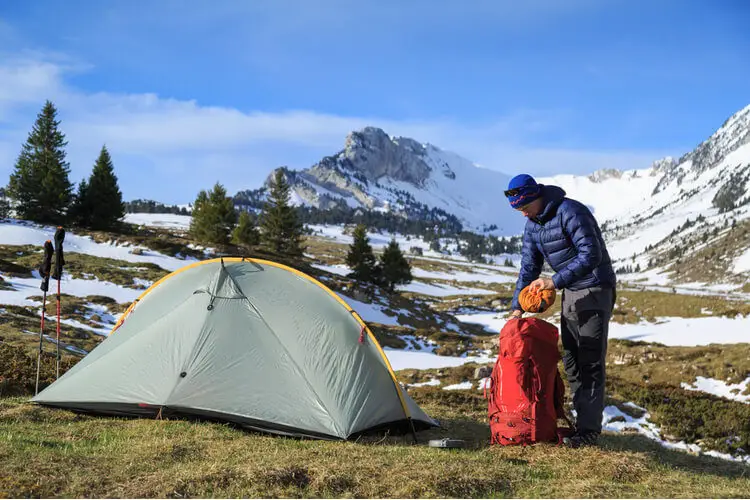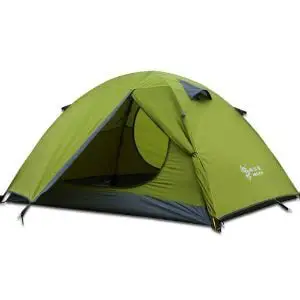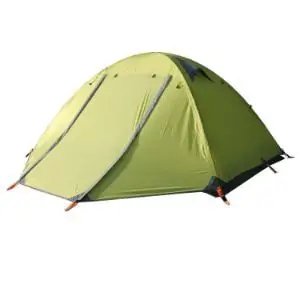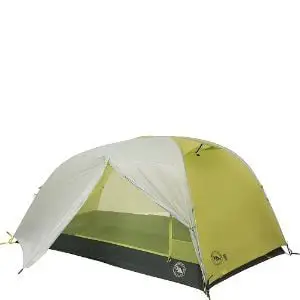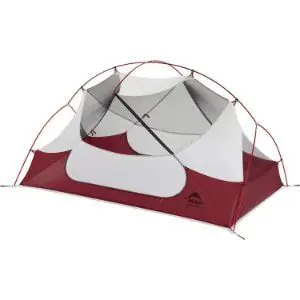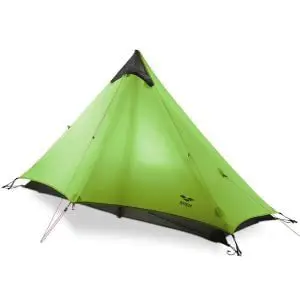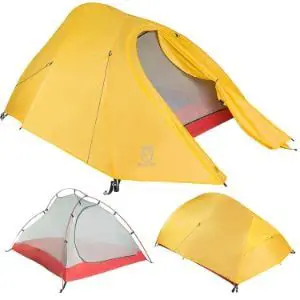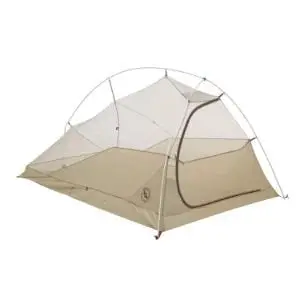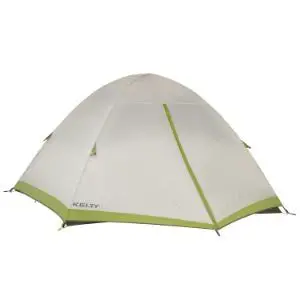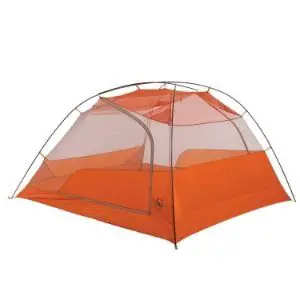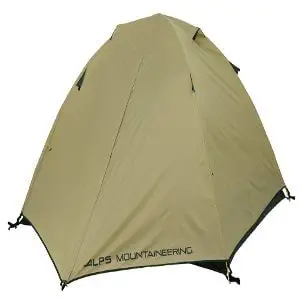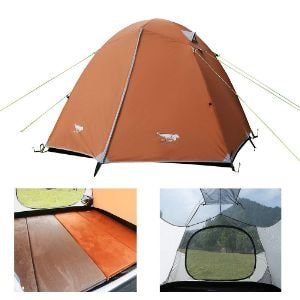Few experiences in life compare to that of loading up a backpack and taking to the trails for an extended trip in the wild. But just what goes into that backpack is perhaps the single greatest factor in determining whether or not that trip will be best filed away under the label ‘adventure’ or ‘misadventure.’ This is never more true than in the case of our tent, which is almost single-handedly responsible for ensuring our nights in the backcountry are both comfortable and adequately sheltered from whatever the weather gods may deem fit to throw our way. To help you choose the ideal tent for your backpacking adventures, in this article we’ll introduce you to our selection of the top 25 backpacking tents out there in 2020.
We reviewed dozens of tents for backpacking to identify the best of the best. We examined a range of factors, including material, capacity, weather resistance, weight, convenience, shape, cost, and average customer reviews.
Having considered a large number of backpacking tents, we chose the MSR Elixir 3-Person Lightweight Backpacking Tent as our top pick. This tent uses a semi-geodesic, double-walled design with highly waterproof floor and rainfly fabrics that provide outstanding all-weather protection. It also weighs just 7 pounds (poles and pegs included), boasts 39.5 square feet of floor space, a huge 24 square feet of vestibule space, and packs a wealth of handy features that vastly enhance the tent’s overall livability.
In This Article
The 5 Top-Rated Tents for Backpacking
| Editor's Picks | Brand | Rating |
|---|---|---|
| Best Tent for Backpacking Overall | MSR Elixir 3-Person Lightweight Backpacking Tent | 4.8 |
| Best 4-Season Backpacking Tent | Naturehike Cloud-Up 2-Person Backpacking Tent | 4.5 |
| Best Budget Backpacking Tent | Clostnature Lightweight 2-Person Backpacking Tent | 4.6 |
| Best Ultralight Backpacking Tent | Big Agnes Tiger Wall Platinum Crazylight Backpacking Tent | 5.0 |
| Best 4-Person Backpacking Tent | Kelty Late Start 4-Person, 3-Season Backpacking Tent | 4.5 |
*Ratings are from Amazon at the time of publication and can change
Best Tent for Backpacking Overall: MSR Elixir 3-Person Lightweight Backpacking Tent
The MSR Elixir 3-Person Lightweight Backpacking Tent is an outstandingly well-made, lightweight, and livable tent that’s ideally suited to three-season backpacking trips for up to three adult sleepers.
What we love most about this tent is that it manages to strike the perfect balance between weight savings, all-weather protection, and livability, and also includes a number of very dialed-in features that are specifically tailored to the needs of the long-term or long-distance backpacker.
The Elixir uses a semi-geodesic, four-pole design that provides outstanding stability in high winds and, thanks to the color-coding system used in the poles, clips, webbing, and grommets, is an absolute cinch to set up, even for camping novices. While made for three people, the tent’s freestanding design also means it’s easy to pitch even if solo camping or your sleeping companions have conveniently disappeared when the time comes do set up camp!
With 39.5 square of interior floor space and a peak height of 41 inches, this isn’t the roomiest 3-person tent out there, but the additional 24 square feet of additional storage space provided by the vestibules means that every square inch of that sleeping area can be used for sleeping gear and sleepers only, while the vestibules can be used to stow all your kit.
With regard to weather-resistance and ventilation, the Elixir ticks all the boxes, too. Its double-walled, two-door design and large mesh panels on the tent body permit plenty of airflow throughout the tent to stave off stuffiness and condensation, while a 1,500 mm HH rainfly and 3,000 mm HH floor are more than capable of dealing with the very worst the weather’s likely to throw at you in three-season conditions.
MSR go the extra mile with this one as regard “bonus” features that contribute to the tent’s overall convenience, livability, and ease of use. The most notable of these features include an adaptable rainfly that can be rolled up partially and clipped in place to provide better views, built-in gear lofts, glow-in-the-dark zipper pulls, and an included footprint that attaches to the rainfly for single-piece pitching.
MSR Elixir 3-Person Lightweight Backpacking Tent Key Features:
- 39.5 square feet of interior floor space
- 24 square feet of vestibule space
- 41-inch peak height
- Semi-geodesic design provides excellent stability in strong winds
- Gear loft for storage
- Color-coded poles, clips, webbing, and grommets
Best 4-Season Backpacking Tent: Naturehike Cloud 2-Person Backpacking Tent
As a general rule, backpackers can usually expect to pay over the odds for a tent that offers solid, reliable, four-season weatherproofing. Not so with the fantastically affordable Naturehike Cloud-Up 2-Person Backpacking Tent.
This wonderfully robust, highly waterproof, and roomy tent costs a fraction of what you might expect to pay for a big-brand, four-season competitor and yet packs everything you need to continue getting your wander on in comfort in the year’s coldest months.
The Cloud-Up’s inner tent is made with 20-denier, anti-scratch nylon mesh to improve breathability and it uses a 20-denier, ripstop nylon and silicone-coated rainfly with a mighty hydrostatic head rating of 4000mm, making it capable of fending off even the most biblical of downpours. The rainfly also offers UV 50+ sun protection and includes an extended “snow skirt” around the base of the tent to prevent rain and snow from collecting under the tent and sneaking into your sleeping area through the flooring.
With 26 square feet of interior floor space and a peak height of 45 inches, this tent offers plenty of elbow and head room for two occupants and also boasts a spacious, 12-square-foot vestibule for gear storage and changes of clothing. While that 26-square-foot capacity might seem a little low compared to two- or three-season models of tent, in winter conditions, the reduction in unoccupied space in smaller tents means you have less space to warm up with your body heat, thus making them far more thermally efficient.
Other admirable characteristics and features found in this tent are its light packed weight (3.8 lbs.), freestanding design, integrated gear loops and gear loft, included footprint, and use of handy ventilating panels in the both the tent body and rainfly. While it doesn’t use color-coded poles or clips to aid setup, even novice users should be able to pitch the tent in just four or five minutes.
Naturehike Cloud-Up 2-Person Backpacking Tent Key Features:
- 26 square feet of floor space
- 12 square feet of vestibule space
- Snow skirt around base of tent
- Weighs just 3.8 lbs.
- Double-walled, freestanding design
- 45-inch peak height
Best Budget Tent for Backpacking: Clostnature Lightweight 2-Person Backpacking Tent
The Clostnature Lightweight 2-Person Backpacking Tent is a great option for backpackers not put off by the idea of carrying a few extra ounces if it means getting an affordable but high-performing backcountry shelter in return for their efforts.
At 5.4 pounds in weight, this tent is far from being the lightest 2-person model in our review. However, every ounce of that weight is put to very good use. The Clostnature uses a full-mesh interior to improve ventilation, while both the rainfly and flooring are made with very tough, 210T polyester fabric with a hydrostatic head rating of 5,000mm, making this one of the most reliably waterproof budget tents on the market.
What we love most about this tent is its livability. Not only does it boast a highly impressive 35 square feet of floor space and a two-doored design with roomy vestibules on each side, it also has a peak height of 47 inches to prevent things getting too claustrophobic on rainy days or long evenings inside the tent, and a large, extendable awning that can be attached to trekking poles or trees to create further sheltered space in front of your tent.
Other nice features included in this tent are burly pole attachment clips on the tent body that facilitate pitching, a handy carry bag, two-way zippers, aircraft-grade aluminum poles, and a duo of ventilation windows in the rainfly to help stave off stuffiness and condensation in more humid conditions.
Clostnature Lightweight 2-Person Backpacking Tent Key Features:
- 34 square feet of floor space
- 47-inch peak height
- Two large vestibules
- 5,000mm HH rainfly and flooring
- Weighs 5.4 lbs.
- Limited lifetime warranty
Best Ultralight Backpacking Tent: Big Agnes Tiger Wall Platinum Crazylight Backpacking Tent
In the Tiger Wall Platinum Crazylight Backpacking Tent, makers Big Agnes have achieved what has been deemed the Holy Grail of backpacking since the first models appeared on the market decades ago—namely, a featherweight backpacking shelter that somehow also manages to offer all the livability and weather protection of a heavyweight. This tent is so light, in fact, that it tips the scales at a lot less than many models of one-person tent, and is also so reliably water and windproof that it bests many far heavier models of tent that offer significantly less overall living space.
But this tent isn’t all about that very back and pack-friendly 2 pound, 11 ounce weight and 19 by 5 inch packed size.
The Tiger Wall is made with silicone-treated nylon rip-stop fabric with a 1,200mm hydrostatic head waterproof coating. While this degree of waterproofing is likely to leak eventually should your find yourself in a sustained torrential downpour, it’s more than adequate for three-season backpacking in most parts of the world. It also features a dry-entry door design that prevents rain reaching the interior as you enter and exit the tent, storm flaps over the zippers, sealed seams, and a single-pole design, color-coded webbing and buckles, and velcro tabs that attach the pole to the rainfly to make setting up and dismantling the tent an absolute cinch.
Other than its portability, what we love most about the Tiger Wall is the wealth of features found on the tent’s interior, all of which contribute to making it one of the most livable ultralight tents out there. These include an oversized gearloft in the ceiling, two interior mesh pockets, media pockets above the sleeping area that allow you to route charge cord or earphones to your device without tangling, multiple gear loops for hanging clothing or accessories, and structured foot-end corners that create more usable space between your feet and tent wall.
All in all, an outstandingly practical and surprisingly comfortable option for those who want to keep weight to an absolute minimum.
Big Agnes Tiger Wall Platinum Crazylight Backpacking Tent Key Features:
- Weighs just 2 lbs. 11 oz.
- 38 square feet of floor space
- Large vestibule
- 42-inch peak height
- 1,200mm HH flooring and rainfly
- Multiple interior storage options
- Color-coded pole, webbing, and buckles
- Lifetime warranty
Best 4-Person Backpacking Tent: Kelty Late Start 4-Person, 3-Season Backpacking Tent
The Kelty Late Start 4-Person, 3-Season Backpacking Tent is a great choice of tent for families of four looking to get in some quality outdoor-time together.
This tent wins our vote as the best four-person model on the market for many reasons, but mainly on account of the fact that it ticks every box in need of ticking at a very reasonable price point.
This tent uses rugged, 68-denier ripstop fabric in the floor and rainfly and a full-mesh tent body to maximize ventilation and breathability and ensure your slumber isn’t interrupted or gatecrashed by any uninvited guests from the insect world. It also boasts a hydrostatic head rating of 1,800mm in the flooring and rainfly, meaning it’s more than capable of dealing with whatever conditions you might encounter on trips in any season outside of winter.
With just under 56 square feet of floor space and a 9.1-square-foot vestibule, the Late Start is more than roomy enough for two adults, two kids and all their gear, and its 56-inch peak height is sure to find favor with anyone in your camping crew prone to claustrophobia or who just prefers a little more headroom when moving around inside the tent.
With regard to setup, the Late Start helps you every step of the way, using a color-coded fly attachment system, pre-bent poles, “quick-corner” sleeve pockets to save squeezing pole ends into grommets, and a freestanding design that makes it possible for one family member to keep an eye on the kids while the other takes care of pitching your home for the night.
Kelty Late Start 4-Person, 3-Season Backpacking Tent Key Features:
- 55.7 square feet of floor space
- 56-inch peak height
- 1,800mm HH flooring and rainfly
- Freestanding design
- Color-coded fly attachment
Who Should Buy a Backpacking Tent
Backpacking tents are specifically designed for use in backcountry environments and, as such, are usually much lighter and more portable than standard camping tents. Their lighter weight allows you to carry them more easily when heading on multi-day trips, thru-hikes, or even on a single overnight trip on which you’ll be carrying your camping kit long distances before setting up camp.
While there’s no reason a backpacking tent can’t be used at an established campsite for car camping, in an effort to cut down on weight and packed size, most backpacking tents skimp on certain features conducive to livability that are commonly found in standard camping tents, most notably a spacious vestibule area, roomy interior dimensions, room dividers, and/or porch areas.
In light of the above, if you plan on doing most of your camping in the backcountry and will have to carry your tent to and from your campsite in your backpack, then a backcountry tent is a far better option. If, however, you envision camping mainly at established campsites that are accessible by car, then a standard camping tent is likely to prove a more comfortable choice.
More of a campsite camper than a backcountry camper? If so, then check out our guide to The Best Tents for Camping!
Important Features to Consider
- Capacity. When buying your tent, your first task in drawing up a shortlist should be to ensure all the tents on there are big enough to accommodate you and camping companions. While most tents are advertised with a person-rating (2-person, 4-person, etc.), for the most part these ratings are untrustworthy and usually overstate the number of adult sleepers the tent can comfortable accommodate. The easiest way to get around this problem is to hunt down the tent’s exact dimensions in the product description. By multiplying the tent’s width by its length, you can calculate its square footage, i.e. a tent that measures 6 feet wide by 8 feet long will have 48 square feet of floor space. Working on the principle that every adult sleeper will require roughly 12-14 square feet of space, you can then gauge whether or not the tent will be suitable and spacious enough for you and your fellow campers.
- Water-resistance. Waterproofing in tents is quantified by an industry-standardized rating known as the hydrostatic head rating. The hydrostatic head (HH) rating of all outdoor products is tested and determined by applying water pressure to the surface of any fabric or material and recording at which point it begins allowing water to leak through. For example, if a fabric starts leaking with 1,200mm of pressure, then that fabric’s hydrostatic head rating will be 1,200mm. To give you and idea of how tents with varying HH ratings can be expected to perform out in the field, take a look at the following:
- 1,000 mm – This is the lowest HH rating required for a tent to be marketed as “waterproof.” In practice, however, a tent rainfly with this hydrostatic head rating will only be capable of withstanding very light and unsustained rainshowers.
- 1,500mm-2,000mm – This rating is commonly found in three-season backpacking tents and tent fabrics with this rating will be capable of fending off both sustained and heavy precipitation.
- 3,000 mm – This rating is only rarely found in backpacking tents and is more common in four-season expedition tents. Tent fabrics with this rating will be able to withstand the heaviest of downpours, even with the added pressure placed upon the fabric by strong winds.
- Weight. The weight of your tent is the biggest determiner of how portable the tent will be. As mentioned above, those who plan on multi-day backpacking trips in their tent as opposed to camping in an established, roadside campsite, portability is of the essence. While backpacking tents are, as a general rule, significantly lighter than standard camping tents, there can be a big difference in weight between models of comparable sizes. Just how light or heavy you should go will ultimately come down to your personal preferences and just how much you are willing to carry or how far you will be travelling between overnight stops on your trip. However, to get a ballpark idea how much backpacking tents of various capacities should weigh, take a look at the following list:
- 1-person: 1.5 to 3.5 lbs.
- 2-person: 3 to 5 lbs.
- 3-person: 5 to 7 lbs.
- 4-person: 7 to 10 lbs.
- 6-person: 12 to 16 lbs.
- Ventilation. With the exception of midges and mosquitoes, few things can cause the average backpacker quite so much grief and annoyance as condensation inside their tent. Condensation and general stuffiness inside tents is caused by poor ventilation, a problem that can be eliminated or at least mitigated if your tent includes the following features:
- A double-walled design that allows for airflow between the tent’s rainfly and the tent body
- Substantial mesh panels on the tent interior (tent body)
- Ventilation panels in the rainfly
- Awnings or large storm flaps above doors that allow you to open the doors to ventilate the tent without exposing the interior to rainfall
- A duo of entrances to permit steady airflow throughout the tent
- Setup. When buying your tent, it’s always wise to opt for a model that facilitates the setup process, particularly if you are fairly new to the game of backpacking. The most important features that aid setup include:
- Color-coded poles, clips, and/or grommets
- A freestanding design that makes it easier to pitch your tent in strong winds or alone
- Clips that connect the rainfly to the tent body to allow you to pitch both in one go (one-piece pitching)
- Storage. The number and size of the storage options included on any tent have a direct impact on the tent’s overall livability and practicality. When you’re buying your tent, we recommend looking for the following features:
- A spacious vestibule in which you can keep wet or dirty gear
- Large storage pockets on the interior that will allow you to store your kit above the floor, thereby providing more room for the tent’s occupants
- A gearloft (a large, hanging storage pocket or “shelf” located in the tent canopy
- Gear loops that allow you to hang clothing and headlamps or other gear items on the tent walls
Frequently Asked Questions
What is a backpacking tent?
Backpacking tents are distinguished from standard camping tents primarily by their portability. While portability hinges on such factors as the tent’s packed size, the most important factor by far is the tent’s weight. Because intended for use on prolonged, multi-day trips during which you’ll be carrying the tent between camping locations, backpacking tents are typically much lighter than comparably sized campsite tents. Also, backpacking tents usually boast more solid waterproofing than standard tents owing to the fact that backpackers are likely to be in the backcountry for longer periods and thus, potentially, exposed to more inclement weather conditions than those camping in established campsites.
Do you need a tent for backpacking?
This very much depends on where and when you’re doing your backpacking. In some areas, popular backpacking trails are served by a network of mountain huts offering accommodation to hikers and backpackers, meaning you can forego carrying any sleeping equipment whatsoever. In most popular hiking, trekking, and backpacking areas, however, the lack of en-route accommodation means that carrying some form of portable shelter will be necessary to provide protection from the elements. Of the available options—tents, bivvy bags, tarp-shelters, and hammocks—tents provide by far the most reliable and comfortable option.
How heavy should a tent be for backpacking?
While no universally agreed-upon weight exists to demarcate a cut-off point between backpacking tents and standard camping tents, the following list offers a ballpark guide to the weight of backpacking tents per capacity:
- 1-person: 1.5 to 3.5 lbs.
- 2-person: 3 to 5 lbs.
- 3-person: 5 to 8 lbs.
- 4-person: 7 to 10 lbs.
- 6-person: 12 to 16 lbs.
Where do you put a tent in a backpack?
Ideally, your tent and other sleeping gear should be stored at the base of your backpack. Doing so is beneficial for two reasons: as one of the heaviest items in your pack, stowing the tent lower on your back will lower your center of gravity, thereby making it easier to maintain balance while on the trails; secondly, all items of sleeping equipment are those that you will use last on any given day while backpacking, therefore storing your tent at the base of your pack instead of at the top means you won’t have to unpack and then repack your tent every time you wish to access other items.
Other Tents for Backpacking We Reviewed
We looked at 20 other tents for backpacking. Even though they didn’t make our 5 best tents for backpacking list, they’re the best of the rest and each is still a great option for your backpacking adventures. The information you’ll need to compare each one is included with the listing.
Budget Tents for Backpacking
Featherstone 2 Person Backpacking Tent
This 2-person tent boasts a roomy 33.5 square feet of floor space, very solid and reliable waterproofing, and weighs in at a reasonably lightweight 6 pounds, making it a great choice for all three-season adventures.
Key Features:
- Weighs 6 lbs.
- 33.5 square feet of floor space
- 3,000mm hydrostatic head rating on flooring and rainfly
Cost: $99.99
V VONTOX Lightweight Backpacking Tent
This very robust, 2-person tent boasts outstanding waterproofing, 31 square feet of floor space, taped seams, and also uses tough, ripstop fabrics throughout, all of which makes it one of the most livable low-cost 3-season tents out there.
Key Features:
- 31 square feet of floor space
- Weighs 5.2 lbs.
- 3,000mm HH flooring and rainfly
Cost: $75
ALLBEYOND 3-Season Backpacking Tent
While not the lightest 2-person backpacking tent out there, this one is roomy enough for two adults, boasts very rugged, waterproof materials, and fully taped seams, making it a great budget option for three-season adventures.
Key Features:
- 30 square feet of floor space
- Weighs 5.5 lbs
- 3,000mm HH flooring and rainfly
Cost: $61
BISINNA 2 Person Lightweight Backpacking Tent
This very affordable, compact little tent ticks all the boxes, boasting 2,000 mm HH waterproofing, taped seams, a 30-square-foot interior, a generous 47-inch peak height, a double-walled design, and plenty of interior storage options.
Key Features:
- 30 square feet of floor space
- 2,000mm HH flooring and rainfly
- Double-door and double-walled design
- Lifetime warranty
Cost: $54.99
HILLMAN 3/4-Season 2-Person Backpacking Tent
The simple, frill-free little tent offers reliable waterproofing, a roomy interior, a generous peak height, and weighs in at just a fraction over five pounds, all of which makes it a good option for three-season wanders for buyers looking to strike a happy balance between weight savings, livability, and weather resistance without breaking the bank.
Key Features:
- 30 square feet of floor space
- 5,000mm HH flooring; 3,000mm HH rainfly
- Weighs 5.06 lbs.
- 43-inch peak height
Cost: $60
Hyke & Byke Zion 2-Person Backpacking Tent
This very roomy two-person tent uses near-vertical walls to increase livable space, boasts impressive waterproofing for such a lightweight tent, and comes with a 5,000mm-rated footprint and large gearloft for interior storage.
Key Features:
- 32 square feet of floor space
- 42-inch peak height
- Weighs 5.49 lbs.
- 5,000mm HH rainfly and footprint (included)
Cost: $99.97
While a fraction heavier than other two-person tents in our review, this tent more than makes up for that slight shortcoming with outstanding waterproofing, a very roomy interior, and a double-doored design that includes two large vestibules for sheltered gear storage.
Key Features:
- 34 square feet of floor space
- Weighs 5.9 lbs
- 45-inch peak height
- 3,500mm HH rainfly; 4,000mm HH flooring
Ultralight Backpacking Tents
Big Agnes Manzanares HV SL mtnGLO Backpacking Tent
This very roomy three-person shelter uses extra-steep walls that increase livable space without adding weight and also boasts solid waterproofing throughout, a wealth of interior storage options, and a 9-square-foot vestibule for gear storage. One of the lightest 3-person backpacking tents out there.
Key Features:
- Weighs 5 lbs.
- 41 square feet of floor space
- 43-inch peak height
- 1,200mm HH in rainfly; 1,500mm HH in flooring
Cost: $274.95
MSR Hubba Hubba NX 2-Person Lightweight Backpacking Tent
A remarkably robust 3-season shelter that offers solid waterproofing, a roomy interior and vestibule area, and uses a hub-and-pole design system that makes setup a piece of cake.
Key Features:
- 29 square feet floor area
- 17.5-square-foot vestibule
- Weighs 3.9 lbs.
- 3 year warranty
Cost: $320
MIER Ultralight Tent 3-Season Backpacking Tent
This very sleek little one-person tent boasts outstanding waterproofing and ventilation, packs down into a tiny, very portable little bundle, and uses a simple, single-poled, double-walled design that allows you to set it up in a matter of seconds (2 minutes for slackers!).
Key Features:
- Weighs just 2.2 lbs.
- Taped seams
- 5,000mm HH rainfly; 6,000mm HH flooring
- 17 square feet of floor space
Cost: $119.99
MIER 2-Person Lightweight Backpacking Tent
This tent boasts just about the best waterproofing you can find, is very easy to set up, weighs in at a tiny 4.6 pounds, and offers a roomy 29 square feet of sleeping space in addition to a 9-square-foot vestibule area.
Key Features:
- 29 square feet of floor space
- Weighs 4.6 lbs.
- 5000mm HH rainfly; 6000mm HH flooring
- 15-denier ripstop rainfly fabric; 40D Nylon ripstop flooring
Cost: $159.99
Paria Outdoor Products Bryce Ultralight Tent
This 2-person tent weighs in at just 3 pounds and 7 ounces, uses rugged ripstop fabrics, and boasts almost peerless waterproofing thanks to a 5,000 mm silicon/PU coating and factory-taped seams.
Key Features:
- 34 square feet of floor space
- Weighs just 3 lbs. 7 oz.
- 5,000mm hydrostatic head rating on rainfly and flooring
- Lifetime warranty
Cost: $159.99
Big Agnes Fly Creek HV UL Ultralight Backpacking Tent
This is the ideal tent for anyone unwilling to settle for anything less than the lightest of the light and best of the best…and not afraid of spending big in order to get their hands on what’s likely to become their go-to tent for a lifetime. This tent weighs a tiny 2 pounds and 5 ounces but offers 28 square feet of floor space, packs down to just 4 x 19 inches, is fully waterproof, and boasts an 8-square-foot vestibule.
Key Features:
- 28 square feet of floor space
- 8-square-foot vestibule area
- Weighs 2 lbs. 5 oz.
- Multiple interior storage options
- 1,200mm hydrostatic head rating
Cost: $342
Big Agnes Seedhouse SL Superlight Backpacking Tent
Weighing just 3 pounds and 12 ounces, this is one of the lightest 2-person, 3-season backpacking tents out there. It’s also perfectly roomy for two adults, waterproof, and built to deal with all the rigors and rough-treatment of backpacking and backcountry environments.
Key Features:
- 28 square feet of floor space
- 8-square-foot vestibule
- Oversized ceiling pocket for gear storage
- Weighs just 3 lbs. 12 oz.
4-Person Backpacking Tents
As with all things Kelty, this tent oozes quality from every stitch and seam. It also boasts a very roomy interior, large vestibule, solid waterproofing, and weighs in at a reasonably lightweight 7 pounds.
Key Features:
- 55 square feet of floor space
- 10-square-foot vestibule
- 1,800mm HH in flooring and rainfly
- Single-piece pitching thanks to clips in tent body
- Weighs just 7 lbs.
Cost: $176
Big Agnes Copper Spur HV UL Backpacking Tent
You may have to rob a bank to get your hands on one, but your efforts will be well worth it! This 3-season tent weighs in at a tiny 5 pounds and 10 ounces but offers outstanding weather-resistance, an impressive peak height of 50 inches, a huge vestibule area, and comes with an incredible lifetime warranty.
Key Features:
- 57 square feet of floor space
- 18-square-foot vestibule
- Gearloft, 8 interior mesh pockets, and 4 media pockets
- Weighs 5 lbs. 10 oz.
Cost: $430
An outstandingly well-made tent that boasts 63.5 square feet of floor space, an incredibly roomy, 25-square-foot vestibule, a 50-inch peak height, and weighs just 10 pounds. A great choice for backpacking trips in three-season conditions for up to four adults or two adults and three kids.
Key Features:
- Weighs 10 lbs. 2 oz.
- 63.5 square feet of floor space
- 25-square-foot vestibule
- 1,500mm HH flooring and rainfly
Cost: $263
Luxe Tempo Lightweight Backpacking Tent
This very reasonably priced 4-person tent boasts the kind of specs and features usually only found on far more expensive models of backpacking tent, including a 3,000mm hydrostatic head rating in the rainfly and flooring, a 7.7-pound packed weight, two large vestibules, and ripstop fabrics throughout.
Key Features:
- 58 square feet of floor space
- 49-inch peak height
- 3,000mm HH flooring and rainfly
- Weighs just 7.7 lbs.
Cost: $129
TETON Sports Mountain Ultra 4-Person Backpacking Tent
This very spacious 4-person tent is very easy to pitch and offers the best ventilation of all the four-person tents in our review thanks to an all-mesh interior and double-doored and double-walled design. It’s also highly waterproof, lightweight, and boasts plenty of interior storage pockets and a large gearloft to free up floor space.
Key Features:
- 57 square feet of floor space
- Weighs 9.5 lbs.
- 3,000mm HH flooring and rainfly
- One-piece pitching
Cost: $190
It may be pricey, but this tent is truly built to last a lifetime and is one of the roomiest four-person models in our review. It also boasts excellent waterproofing, a robust design that remains stable in high winds, and weighs in at a very portable 8.1 pounds.
Key Features:
- 60 square feet of floor space
- Weighs 8.1 lbs.
- 2 x 12-square-foot vestibules
Cost: $359.95
